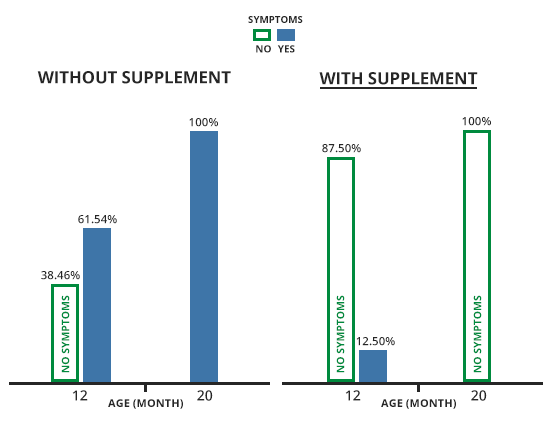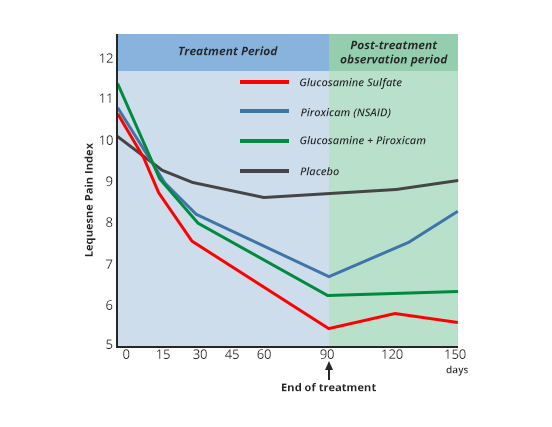- Home
- Joint Pain

- Food / Diet

- RESEARCH
CLINICAL RESEARCH ON JOINT SUPPLEMENT AND GLUCOSAMINE

Over the years, researchers and veterinarians alike have studied the resounding issue of dog hip arthritis or canine joint deterioration. In United States, one in four of 77 million dogs are found to have some form of joint problem, and 80% of dogs with the age over 8 have arthritis. Osteoarthritis on the other hand, is a slow debilitating disease that affects canines of all breeds. Its impact affects the dog’s quality of life, comfort, daily function, activity, behavior, and companionship.
As dogs age, joint degeneration comes naturally. Its forms include defective articular cartilage structure, inadequate cartilage biosynthesis, joint trauma, instability, and inflammatory mechanisms. The disease presents with symptoms such as pain, stiffness, lameness, and disability
The common areas of bone and joint pain for dogs are: (1) Intervertebral Joints (the joints between the vertebrae of the spine), (2) Hip, (3) Shoulder, (4) Knee, (5) Elbow, and (6) Carpus or Hock.
With this reason, thousands of products and brands have been produced to fight the joint issue. However, most of these are made from synthetic and toxic components.
Because of ongoing studies and researches, thankfully, we can now avoid these toxic substances in exchange for their joint regeneration.There are healthy natural ingredients have been recognized to effectively enhance bone and joint health. These ingredients can alleviate discomfort and stop the progression of degenerative joint conditions.
Aging Dog Blog’s research pursues to scrutinize the natural joint health ingredients and establish the methods for introducing these to your dog’s diet.
WHY USE JOINT HEALTH SUPPLEMENT
These natural joint supplements are composed of several ingredients. Each ingredient has been the subject of numerous clinical trials showing its efficacy to alleviate joint problems, build strong bones, maintain healthy cartilage, and support joint functions.
A joint supplement is a chewable tablet or a pill that contains ingredients to support mobility and maintain joint health. Its potencies and ingredients vary widely. However, the most common ingredients are glucosamine, chondroitin, and MSM.
In a study entitled ‘Efficacy of an oral hyaluronate and collage supplement as a preventive treatment of elbow dysplasia’, a randomized controlled trial administered by Animal Welfare Committee of the Organización Nacional de Ciegos Españoles (ONCE) Guide Dog Foundation, found out that treated group with supplement has shown lower rate of elbow dysplasia development. The supplement contained hyaluronic acid, hydrolyzed collagen, glucosamine, chondroitin sulfate, and gamma oryzanol. In 20 months of trial, nearly all dogs in control group (no supplement administration), showed symptoms, while almost none of the treated dogs had joint symptoms associated with joint dysplasia.

GLUCOSAMINE
Glucosamine is a chemical compound produced naturally in our bodies. It also comes in an over-the-counter arthritis remedy. It is known as a chondroprotective agent used to treat arthritis in humans, dogs, horses, and other animals.
Glucosamine helps stimulate the production of proteoglycans (building block of cartilage) to maintain health and sturdiness of joints and connective tissues. It also helps maintain synovial fluid to lubricate joints and reduce joint friction.
In addition, glucosamine is often used in conjunction with another substance, chondroitin sulfate, which also helps stimulate cartilage repair. Chondroitin is derived from seafoods, livestock, or synthesized from plant sources in laboratories.
The U.S. Food & Drug Administration (FDA) states glucosamine is a dietary supplement, not drug – which is why it’s not subjected to the extensive pharmaceutical review as products labeled as dietary supplements are evaluated for safety.
Through further studies, it is found that one of its form – glucosamine hydrochloride – had an insignificant effect, while on the other hand, its other common form – glucosamine sulfate – offered pain relief more effectively than analgesic or non-steroidal anti-inflammatory drugs. Because of its low adverse effects, it’s determined as a solution for osteoarthritis management. Studies also have shown that it is proved useful in combination with natural products.
In 2007, the College of Veterinary Medicine in University of Georgia, Athens, conducted 16 clinical trials and systematic review of treatments for osteoarthritis in dogs. It is reported in the Journal of the American Veterinary Medical Association that glucosamine have a moderate level of comfort, on par with most prescription drugs.
Furthermore, 10 years later, in February 2017 article in Open Veterinary Journal, it is concluded that glucosamine and chondroitin are recommended by veterinarians as alternative for treating osteoarthritis in canines.
How long do we need to take glucosamine products take to reduce pain? Most clinical trials show that glucosamine provides substantial comfort in about a month and produce maximum results in 2-3-month mark.

The figure above states that in this study, glucosamine sulfate in red performed better than NSAID in blue plus glucosamine, and placebo. After discontinuing the treatment, results were also monitored. The results show that glucosamine patients maintained some degree of comfort whereas other treatments returned to experiencing pain at a faster rate.
The current recommendations for glucosamine are to take it until maximum results are felt (1 month to 3 months), then for maintenance, use it in alternating months.
It is noted that compared to toxic substances that are commonly used as alternative to cure joint pain, glucosamine has few side effects:
- • Allergies (specifically if allergic to shellfish)
- • Fatigue
- • Insomnia
It is imperative to consult your veterinarian before giving your dog glucosamine to determine your dog’s condition and the corresponding correct dosage. The formulations that are available today in the market are in the forms of oral, flavored tablets, pills, powders, or liquids. These glucosamine formulations are available online, or pet supply stores and veterinarian’s offices.
CHONDROITIN
Chondroitin sulfate, or simply chondroitin, is a major glycosaminoglycannaturally found in cartilage and connective tissues in people and animals. For now, animal cartilage is the only source of chondroitin. But thanks to technology and modern synthesis methods, it is now commercially available in a form of chondroitin sulfate.
It commercially comes in oral form such as supplement tablet or pills to replenish glycosaminoglycan layer that protects musical surfaces. Some choose it to be administered through injectable form to treat degenerative disk diseases (injected directly to cartilaginous pads between vertebrae).
Studies show that chondroitin is best used along with another natural supplement, glucosamine. In a study by Department of Small Animal Clinical Studies, UCD Dublin, in Belfield, Ireland, entitled ‘Randomized double-blind, positive-controlled trial to assess the efficacy of glucosamine/chondroitin sulfate for the treatment of dogs with osteoarthritis’, it is found out that dogs who received glucosamine and chondroitin combination has statistically significant improvements on joint and cartilage health while reducing pain involved
While it is a popular treatment for osteoarthritis, itgreatly helps reduce pain, ensure adequate shock absorption, increase joint mobility, and decrease the need for painkillers.
Since chondroitin is not yet an established treatment, its ideal dosage is still uncertain. Some researchers have used 800 up to 2000 milligrams in either single or divided doses up to 3 years.
Side effects from chondroitin intake are rare and it has extremely low risk of any adverse effects. It is generally safe for most people and animals. Although, some reported having
- • Headaches
- • Mood changes
- • Rashes
- • And other light symptoms
Talk to your veterinarian to make sure your dog can indeed take supplements with chondroitin. Some reported hypersensitivity if one has allergy with shellfish. Since chondroitin is also an agent for blood thinning, there are some risks in people or animal that has bleeding disorders.





